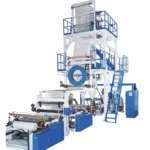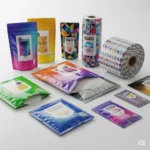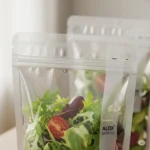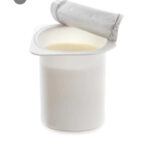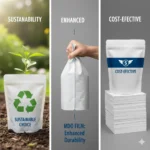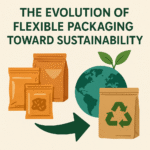In today’s fast-paced world, brands are constantly seeking smarter, more sustainable ways to deliver their products. One packaging solution that’s been making waves across industries is flexible packaging. From snacks and frozen foods to personal care and pet products, flexible packaging is everywhere—and it’s no accident.
But what’s behind this packaging revolution? Why are companies of all sizes shifting from traditional rigid containers to flexible options?
Let’s unpack the reasons why flexible packaging is gaining popularity and why it’s here to stay.
What Is Flexible Packaging?
Before we dive in, let’s quickly define it. Flexible packaging refers to any packaging made of materials that can easily change shape—think plastic films, foils, and pouches. Unlike rigid packaging like glass jars or plastic tubs, flexible packaging conforms to the shape of the product and often comes with features like resealable zippers, spouts, and tear notches.
1. It’s Lightweight and Cost-Efficient
One of the biggest draws of flexible packaging is its lightweight design. Since it uses less material than rigid alternatives, it reduces both production and shipping costs. For brands, this means savings on raw materials and transportation. For consumers, it means easy-to-carry packages that take up less space in bags, cupboards, and fridges.
Key Benefits:
- Lower shipping and storage costs
- Reduced fuel consumption during transport
- Less material waste
2. Sustainable Packaging That Meets Consumer Demands
Sustainability is no longer just a buzzword—it’s a demand. Today’s consumers are more eco-conscious than ever, and they expect brands to follow suit. Flexible packaging helps companies meet sustainability goals in several ways:
- Lower carbon footprint due to lighter weight
- Use of recyclable or biodegradable materials
- Less food waste through improved barrier protection and resealability
Many flexible pouches can now be made with mono-materials, which are easier to recycle. As technology continues to improve, expect flexible packaging to become even greener.
3. Superior Product Protection and Shelf Life
When it comes to keeping products fresh, flexible packaging delivers. Thanks to high-barrier films, flexible packaging can protect contents from oxygen, moisture, light, and contaminants. This is especially critical for food, pharmaceuticals, and cosmetics.
The result? Longer shelf life, better quality retention, and fewer returns due to damaged goods. It’s a win for both manufacturers and customers.
4. It Offers Incredible Design Flexibility
Another reason flexible packaging is so popular is its customization potential. Whether you’re a startup or a global brand, flexible packaging gives you the freedom to:
- Choose from various sizes, shapes, and finishes
- Add eye-catching designs and graphics
- Include functional features like resealable zippers, spouts, or hang holes
This design flexibility improves brand visibility on crowded shelves and allows for more targeted marketing
5. It Enhances Consumer Convenience
Let’s face it—modern consumers love convenience. They want products that are easy to open, close, store, and carry. Flexible packaging answers all these needs.
Whether it’s a pouch that stands upright on the shelf or a resealable snack bag for on-the-go munching, flexible packaging is designed with the user in mind.
Common Features That Add Value:
- Easy-open tear notches
- Resealable zippers and spouts
- Lightweight, portable formats
It’s no surprise that flexible packaging is particularly popular in busy households and among younger consumers who value speed and simplicity.
6. It’s Ideal for E-Commerce and Direct-to-Consumer Brands
The rise of e-commerce has created new challenges for packaging. Products must survive the journey from warehouse to doorstep—and still arrive looking good. Flexible packaging is proving to be a strong ally in this area.
Because it’s lightweight, durable, and space-efficient, flexible packaging helps e-commerce brands reduce shipping damage, cut logistics costs, and offer frustration-free unboxing experiences.
7. Innovation Is Driving Even More Growth
Flexible packaging isn’t static. New technologies are continuously pushing the boundaries of what it can do. Innovations like smart packaging, QR codes, temperature-sensitive inks, and active packaging are adding new layers of functionality.
For example, some flexible packages now include sensors that change color when food is no longer safe to eat, helping reduce waste and improve food safety.
This level of innovation is one of the reasons flexible packaging is being adopted so rapidly across industries.
Which Industries Are Leading the Shift?
While flexible packaging is used across virtually all sectors, a few industries are leading the charge:
- Food & Beverage: Resealable snack pouches, sauce sachets, juice spouts
- Health & Beauty: Travel-sized cosmetics, single-use wipes
- Pet Care: Treat bags, food pouches with zip closures
- Household Products: Refill packs for cleaning supplies, detergents
Each of these sectors benefits from the unique combination of cost savings, functionality, and branding opportunities flexible packaging provides.
Conclusion: The Future Is Flexible
From sustainability and cost savings to design versatility and consumer convenience, the advantages of flexible packaging are hard to ignore. As more businesses look for smarter ways to meet consumer expectations and reduce environmental impact, flexible packaging is positioned as the future of modern product packaging.
It’s clear why it’s gaining popularity—not just as a trend, but as a strategic, long-term solution.
So whether you’re a startup planning your first product launch or a legacy brand rethinking your packaging strategy, now is the time to explore what flexible packaging can do for you

